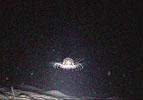
Montreal: A giant ice shelf the size of 11,000 football fields has snapped free from Canada`s Arctic, scientists said.
The mass of ice broke clear 16 months ago from the coast of Ellesmere Island, about 800 kilometers (497 miles) south of the North Pole, but no one was present to see it in Canada`s remote north.
Scientists using satellite images later noticed that it became a newly formed ice island in just an hour and left a trail of icy boulders floating in its wake.
Warwick Vincent of Laval University, who studies Arctic conditions, traveled to the newly formed ice island and could not believe what he saw.
"This is a dramatic and disturbing event. It shows that we are losing remarkable features of the Canadian North that have been in place for many thousands of years. We are crossing climate thresholds, and these may signal the onset of accelerated change ahead," Vincent said Thursday.
In 10 years of working in the region he has never seen such a dramatic loss of sea ice, he said.
The collapse was so powerful that earthquake monitors 250 kilometers (155 miles) away picked up tremors from it.
The Ayles Ice Shelf, roughly 66 square kilometers (41 square miles) in area, was one of six major ice shelves remaining in Canada`s Arctic...
Using US and Canadian satellite images, as well as data from seismic monitors, Copland (head of the new global ice lab at the University of Ottawa) discovered that the ice shelf collapsed in the early afternoon of August 13, 2005.
"What surprised us was how quickly it happened," Copland said. "It`s pretty alarming.
"Even 10 years ago scientists assumed that when global warming changes occur that it would happen gradually so that perhaps we expected these ice shelves just to melt away quite slowly, but the big surprise is that for one they are going, but secondly that when they do go, they just go suddenly, it`s all at once, in a span of an hour."
Within days, the floating ice shelf had drifted a few miles (kilometers) offshore. It traveled west for 50 kilometers (31 miles) until it finally froze into the sea ice in the early winter.
The Canadian ice shelves are packed with ancient ice that dates back over 3,000 years. They float on the sea but are connected to land.
Derek Mueller, a polar researcher with Vincent`s team, said the ice shelves get weaker and weaker as the temperature rises. He visited Ellesmere`s Ward Hunt Ice Shelf in 2002 and noticed it had cracked in half.
"We`re losing our ice shelves, and this a feature of the landscape that is in danger of disappearing altogether from Canada," Mueller said. "In the global perspective Antarctica has many ice shelves bigger than this one, but then there is the idea that these are indicators of climate change."


